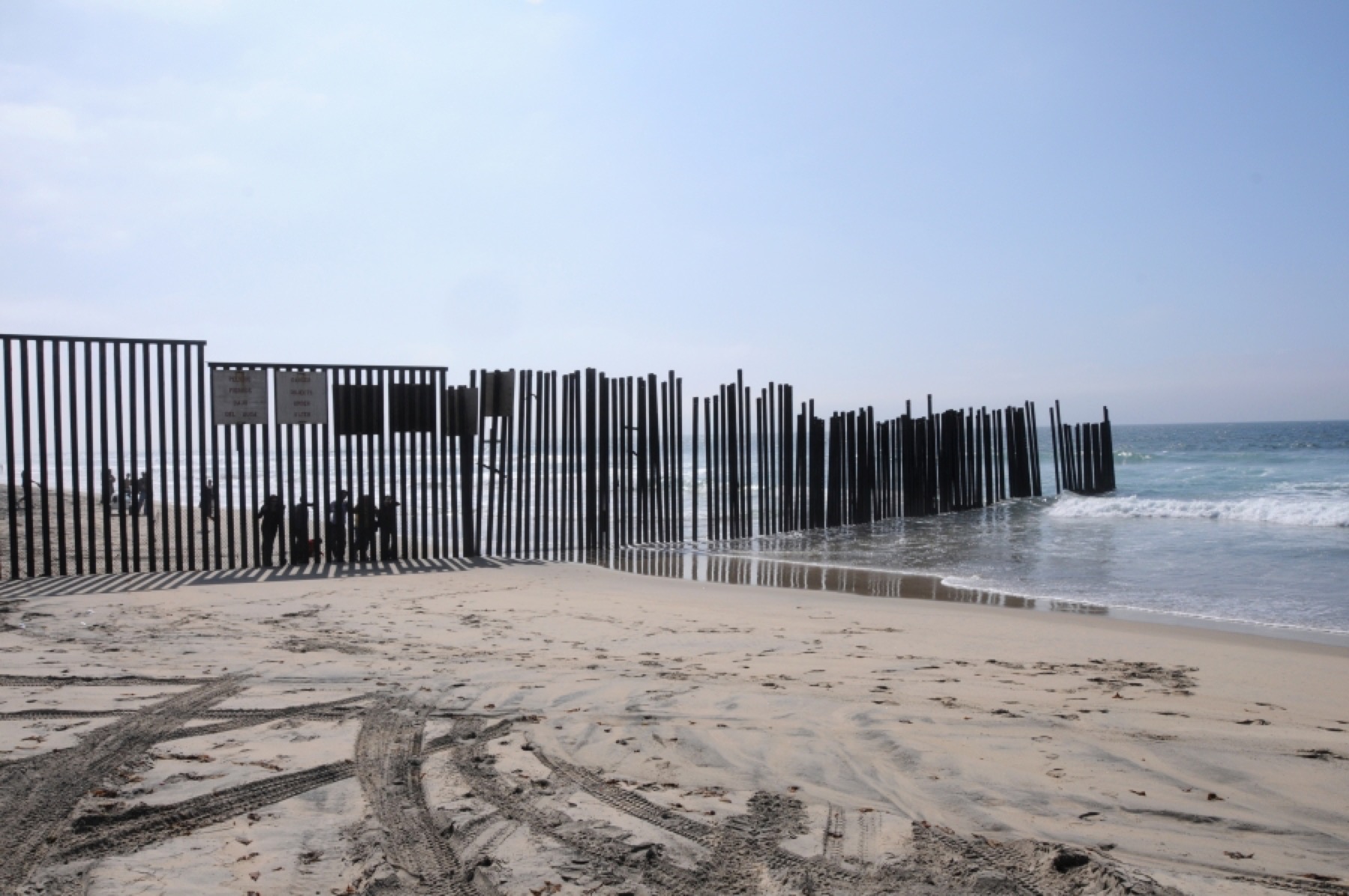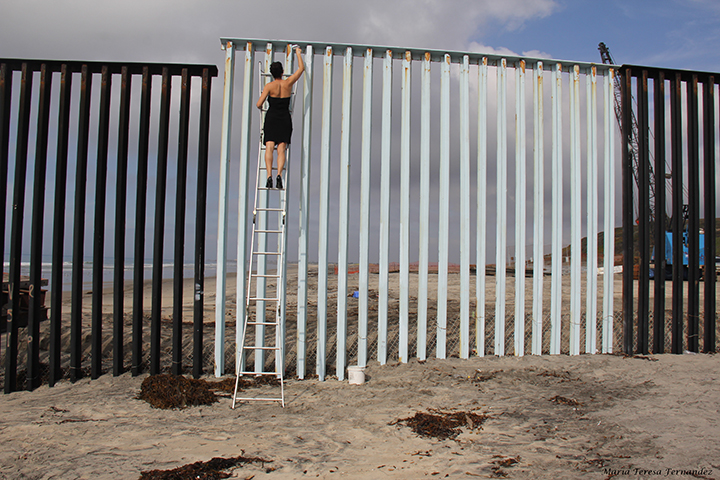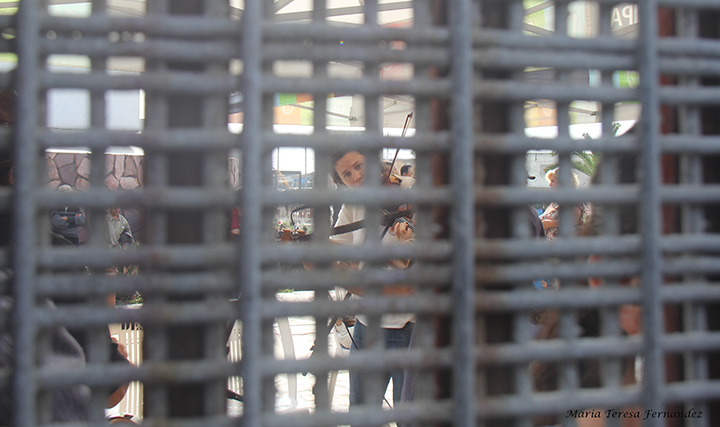
MUSIC WITHOUT BORDERS
By Stephanie Elizondo Griest
Despite its cheerful name and oceanic view, Friendship Park—the swath of land where San Diego meets Tijuana—has also been deemed the “most heartbreaking place in America.” If you approach on the northern side, you’ll make a forty-minute hike through California’s Border Field State Park, before entering what appears to be a prison yard where Border Patrol agents mill about. There, two eighteen-foot steel walls loom ahead, though if you arrive during “visiting hours”—10 A.M. to 2 P.M. on Saturdays and Sundays—you’ll be granted passage into the smaller park inside, joining dozens of families who have traveled tens or thousands of miles in hopes of catching a distorted glimpse of their loved ones through the steel mesh that divides the United States and Mexico. Mothers and sons, husbands and wives lean against steel, attempting to connect through the international borderline. Quietly, they murmur into each other’s ears. They stroke each other’s fingertips through the fence—perhaps experiencing their first bodily contact in years.
Not long ago, Friendship Park was a joyful place. First Lady Pat Nixon inaugurated it in 1971 after ordering her security team to snip the barbed wire fence that used to separate San Diego from Tijuana. “I hope there won’t be a fence here too much longer,” she told the crowd. For decades afterward, the park was one of the only places where Mexicans and Americans could meet document-free in the borderlands. Families would spread out beach blankets and swap tamales and kisses between the gaps in the fence as their children splashed in the nearby Pacific.
But once Congress passed the 2006 Secure Border Fence Act, the U.S. government began a series of renovations resulting in the current double wall that would have closed the park entirely if local activists hadn’t intervened.
“A lot of organizations galvanized, and we launched demonstrations against the plan,” said Rev. John Fanestil, a member of the group Friends of Friendship Park. “The years 2009 to 2011 were just horrible; the Border Patrol wouldn’t let anyone inside the park. People would drive thousands of miles to visit their families and be stopped a hundred feet away at the gate.”
After securing rights for weekend visitations, activists began working toward restoring the park’s humanity by transforming the eighteen-foot barricade into a stage for binational poetry readings, dance performances, yoga classes, volleyball games, and ecumenical communions. Their signature event is the Fandango Fronteriza, which draws hundreds of musicians to the wall each May for a jam session. When I shared footage from the event with master violinist Jennifer Curtis of Chapel Hill, North Carolina, she vowed: “I am so playing there.”
Last December, Curtis and I flew to San Diego with her 1777 Vincenzo Panormo violin in tow. The plan was for Curtis and other American musicians to serenade the northern side of the wall while Tijuana composer Victor Pichardo led a Mexican ensemble on the southern side, but logistics intervened. For starters, the Border Patrol permits no more than twenty-five visitors at a time inside the U.S. portion of Friendship Park, and we couldn’t bear the thought of stealing a spot from a visiting family member. Then, despite their initial enthusiasm, the American musicians started dropping out as show time drew near. Finally, Curtis—a Spanish-speaker who has performed in some of Latin America’s top venues—decided she’d rather express solidarity with her Mexican colleagues by playing on their turf instead of her own.
Though I supported this decision, it unnerved me too. As I write in “Art Against the Wall,” all of my friends and family in South Texas stopped traveling to border towns a decade ago. The threat of drug-violence is too grave—and Tijuana has one of the highest homicide rates, not just in Mexico but in the world. My foremost association with the city, in fact, is El Pozolero (that is, “The Stew Maker”): the gangster who disposed of his boss’s narco-victims by dissolving their bodies in barrels of acid.
Yet once I decided to cross the border, it didn’t take long to succumb to the city’s lure. Pichardo picked us up at the border crossing and, as we sped toward the Pacific, I saw hundreds of murals along the highway as if in defiance of the massive steel wall suturing the surrounding hills. We settled down for a drink at a candle-lit bistro in Playas de Tijuana, the beachside neighborhood whose boardwalk ends at the border wall. The ocean undulated a hundred feet away, and though it was evening in December, we wore only light jackets; the beer was insanely good (and cheap). Curtis announced that we could use another musician for our performance when a young busker ambled by strumming a charango and blowing a panflute. He happily accepted our invitation to perform the following day.
 Ana Teresa Fernandez attempts to erase the U.S.-Mexico border wall from the Tijuana side by painting it blue
Ana Teresa Fernandez attempts to erase the U.S.-Mexico border wall from the Tijuana side by painting it blue
in her performance, “Borrando La Frontera.” Photo by Maria Teresa Fernandez
What really sold me on Tijuana was our stroll along the boardwalk the next morning. Practically every standing structure was someone’s canvas. A two-story painting of Nelson Mandela graced a condo wall; a skeleton gripped a bottle of tequila; Che Guevara smoked a cigar up a flight of stone steps; a pretty woman gazed out a windowsill. Banksy-style stencils depicted children at play and workers at rest. Political graffiti was scrawled across the building tops and coffee houses and cafés were vividly painted turquoise and tangerine. Mingling in between were pork rind vendors, popsicle vendors, corn-on-the-cob vendors, and taco vendors serving fried fish in a double corn tortilla spritzed with a wedge of lime.
Beyond these many delights stood the border wall. Its tall steel rods extended down into the ocean, as if denying passage to sea life as well as humans. Yet the artists who had decorated the boardwalk could plainly not be blocked. Massive banners featuring black-and-white photographs of migrant farmworkers hung along the wall. As we drew closer, we saw that many of the stakes had been individually inscribed:
Rompamos Los Muros. Let’s Break Down The Walls.
Libre Como El Mar. Free As The Sea.
Bienvenidos A La Gran Prision Del Norte. Welcome To The Great Prison Of The North.
One stretch was painted a faded gray-blue: the artist Ana Teresa Fernandez’s attempt to erase the wall altogether a few years back.
We arrived at El Parque de la Amistad—the Mexican half of Friendship Park—about an hour into visitations. Families were huddled every few feet along the wall. Mothers held up babies for new fathers, uncles, and cousins to see. Teenagers snapped photos through the pencil-sized mesh holes. Lovers pressed their entire bodies against the wall, as if to transmit their aura (if not a little heat).
Someone on the other side called out my name. I looked around to find the beckoning silhouette of a man wearing a broad-rimmed hat. It was Rev. John Fanestil, one of the hosts of our event. He raised his hand in greeting and held it against the wall. I repeated the gesture, surprised by its intimacy. Communicating with someone through steel mesh requires total focus. Your eyes must fix directly upon them to see through the tiny holes. You must drown out all sounds to hear your companion’s words. Fanestil introduced me to the photographer Maria Teresa Fernandez, who supplied some of the artwork for my OA story, and Enrique Morones of the Border Angels, an activist group that supports undocumented workers during their crossing. Curtis’s cousin was in attendance on the northern side, having driven in from San Diego. Later, Curtis described the sensation of seeing her relative through the wall as feeling “a cage around your heart.”
From there, we rounded up the musicians. It was quite the motley crew: One Julliard-trained, acclaimed violinist from Appalachia. Two sopranos from the Tijuana Opera. The charango-player we’d met the night before, who hailed from Mexico City. An electric guitarist, a percussionist, and an accordionist who hadn’t played in years. Nearly all were meeting for the first time and none had ever made music together before this day. But Curtis corralled them into a five-minute huddle and then they played nonstop for two hours. Vintage boleros like “Besame Mucho” (Kiss Me A Lot). Extended traditional Andean jams born out of songs like “Flight of the Condor.” Most memorable was their rendition of “La Llorona,” the mournful ballad about the wailing ghost-woman of Mexican folklore.
The voices of Norma Navarrete and Ana Laura Rojas personified the sadness of Curtis’s violin as she arpeggiated the loss of human movement through her chord progressions. Impervious to any border, the music rose above the murmurings of conversations, the crush of the waves, the silence of the steel.
 Jennifer Curtis serenades the United States from Parque de la Amistad in Tijuana. Photo by Maria Teresa Fernandez
Jennifer Curtis serenades the United States from Parque de la Amistad in Tijuana. Photo by Maria Teresa Fernandez
“It wasn’t a concert,” Curtis told me. “It was a shared experience of getting to know one another, of six people bringing their voices together to create one voice. It was about giving reverence to land and giving reverence to ancestry and giving reverence to music itself.”
The music ceased at 1 P.M. so that Iglesia Fronteriza, or Border Church, could begin. The musicians hugged and laughed as they snapped photos of each other, reveling in the camaraderie of shared art.
As we prepared for departure, I decided that Friendship Park’s moniker is true. With all its guards and locks and rules, it really might be the most heartbreaking place in America. But the democracy of art has turned El Parque de la Amistad into one of the most vibrant places, too.
Read “Art Against the Wall” by Stephanie Elizondo Griest

